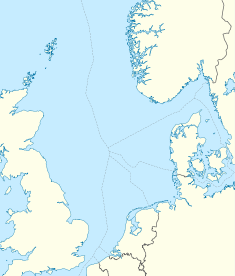Clair oilfield
| Clair oilfield | |
|---|---|
| Location of Clair oilfield | |
| Country | Scotland |
| Region | Scottish Territorial Waters |
| Location | West of Shetland |
| Block | 206/7; 206/8; 206/9; 206/12; 206/15 |
| Offshore/onshore | offshore |
| Coordinates | 60°45′N 2°24′W / 60.750°N 2.400°WCoordinates: 60°45′N 2°24′W / 60.750°N 2.400°W |
| Operator | BP |
| Partners |
BP ConocoPhillips Chevron Corporation Royal Dutch Shell Amerada Hess |
| Field history | |
| Discovery | 1977 |
| Start of development | 2001 |
| Start of production | 2005 |
| Production | |
| Estimated oil in place | 5,000 million barrels (~6.8×108 t) |
| Producing formations | Devonian to Carboniferous continental sandstone |
The Clair oilfield is an offshore oil field in Scottish territorial waters 75 kilometres (47 mi) west of Shetland in water depths of up to 140 metres (460 ft). It extends over an area of some 220 square kilometres (85 sq mi), covering five licence blocks.
The Clair reservoir was discovered in 1977, with exploration well #206/8-1a penetrating a 568-metre (1,864 ft) oil column in a thick sequence of Devonian to Carboniferous continental sandstone. In the 1980s ten appraisal wells were drilled. This activity demonstrated that the structure extended to an area of some 400 square kilometres (150 sq mi) with static oil-in-place, although it failed to confirm the presence of economically recoverable reserves. Two further wells were drilled in 1991, two in 1992 and one in 1995. Two of these wells (206/8-8 and 206/8-9z) demonstrated the potential for commercial flow rates but were not produced for long enough to give confidence in long term reservoir deliverability.
In 1996 there was a breakthrough in the drilling and extended well testing (EWT) of well #206/8-10z. The EWT was followed by the side-tracking of an offset well into the pressure sink created by the EWT. The 1996 well test results set the scope for the 1997 drilling programme and triggered interest in a first phase of development. Two further wells were drilled in 1997 to appraise the 'Graben' and '3A' segments to reduce uncertainty in these areas adjacent to the core area.
In May 1997 it was agreed by the Clair partners to jointly develop the field. BP was appointed as the operator and programme coordinator. A development plan was approved in 2001, representing an investment of £650m by BP and its four partners in the project – ConocoPhilips, ChevronTexaco, Enterprise, and Amerada Hess. The production facilities were installed in 2004. The first stage of the development was inaugurated on 23 February 2005.
The first phase of development targets the 'Core', 'Graben' and 'Horst' segments of the southern area of the reservoir, which have 1.75 billion barrels (278×106 m3), of which 250 million barrels (40×106 m3) can be recovered. The development plan includes drilling of 15 producing wells, eight water injectors and one drill cuttings re-injection well. Plateau production is expected to be 60,000 bbl/d (9,500 m3/d) of oil and 20 million cubic feet per day (570×103 m3/d) of gas.
...
Wikipedia

